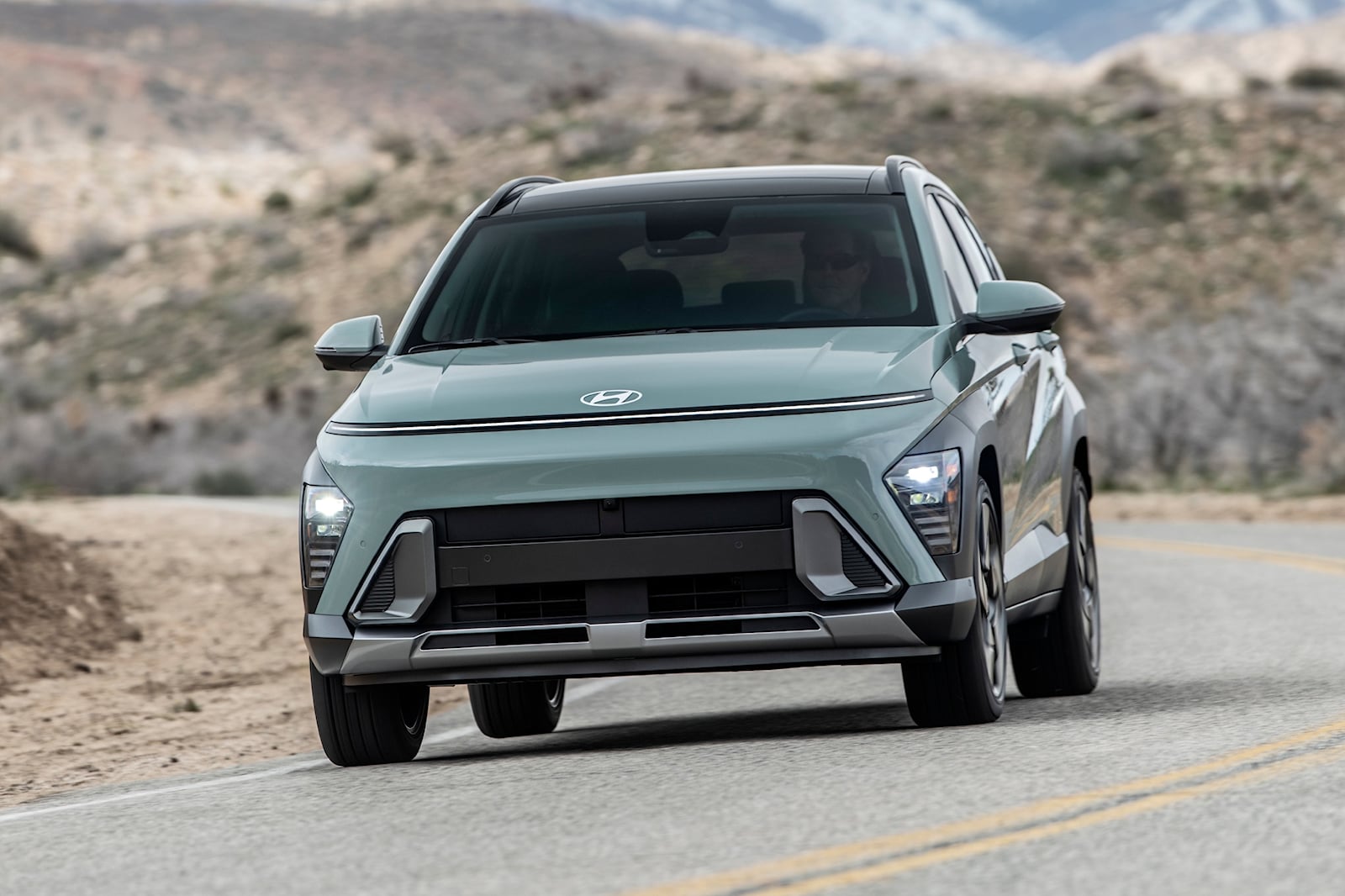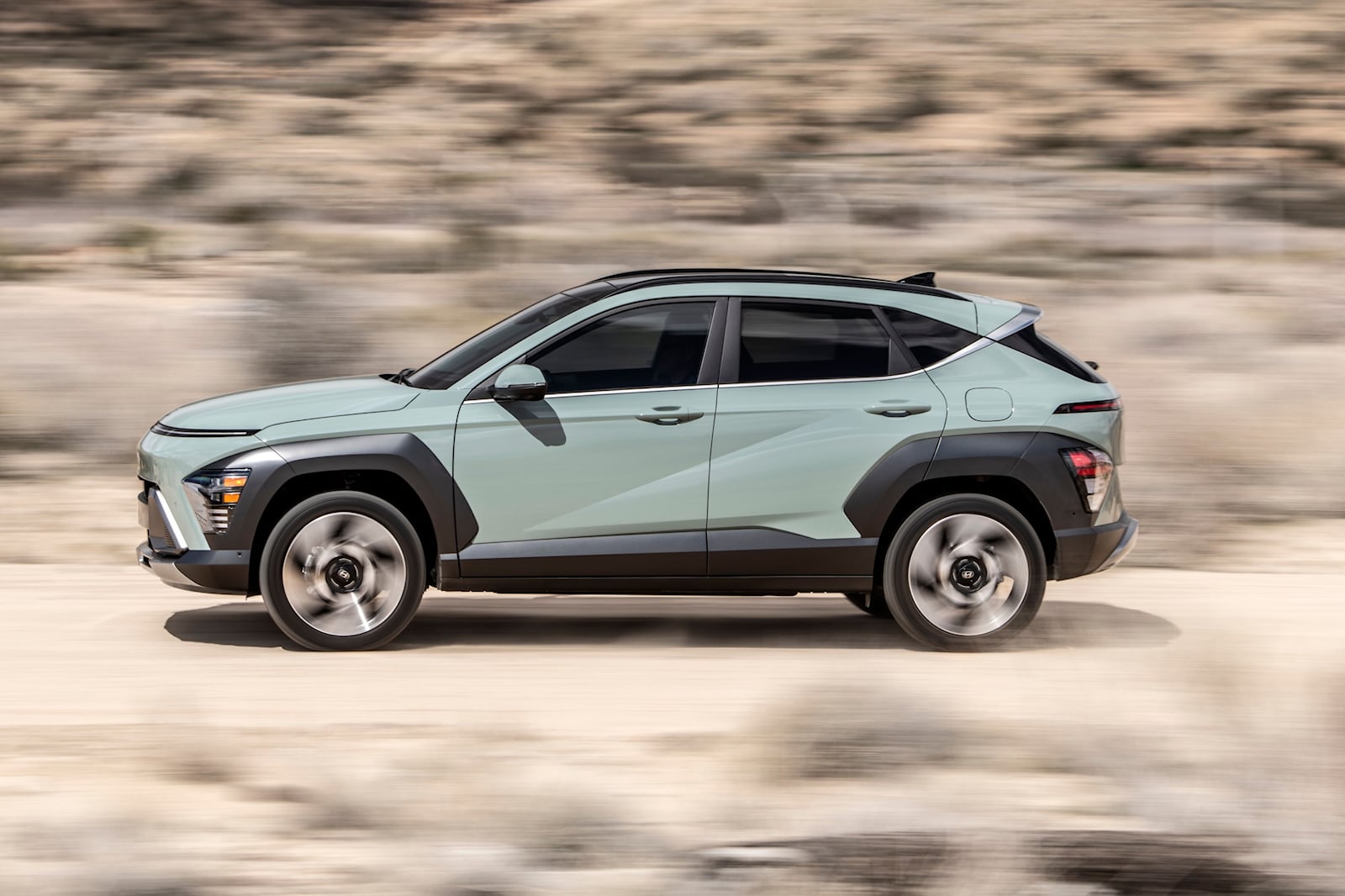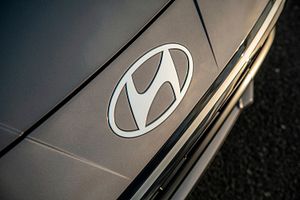A redesigned Hyundai Kona has gone on sale in the USA, and it takes over from an excellent predecessor that never felt its age, even at the end of its career. Not everything about the 2024 Hyundai Kona is new, and its price has increased a little, but this is more than compensated for by the additional features that are now standard. The second-generation car was designed as an EV first, so with the focus very much on the electrified models, Hyundai has not moved the game on much for the regular gas Konas; they still come with the same two engines the old Kona had. The base unit is a timid, naturally aspirated 2.0-liter four-cylinder with 147 horsepower, while the top two trims get a turbocharged 1.6-liter four-pot with a more useful 190 hp. Fortunately, the Kona has not lost its fun-to-drive character despite growing in size and weight. But the competition is tough, with the sweet-driving Mazda CX-30 gunning for class honors, so the gas Konas face an uphill battle. Other rivals, such as the practical Volkswagen Taos and high-value Kia Soul, are also spoiling for a fight. Does the new Kona have what it takes to dispense with its challengers?
The 2024 Kona has a brand-new body that has grown in length over a longer wheelbase, with greater width and height dimensions as well, in addition to a weight increase of 100-200 pounds. Its super modern styling with a distinctive full-width front light bar is very similar to the facelifted Sonata sedan, and it follows the new corporate style. Equipment levels are higher across the board this year, with bigger wheels fitted, standard LED headlights, and additional standard features like push-button start and a significantly larger infotainment display. The same two engines do duty here as in the old car, but the 1.6L turbo loses 5 hp, and its seven-speed dual-clutch automatic is replaced with a new eight-speed torque-converter automatic instead.
The Hyundai Kona SE's MSRP is $24,100 this year, followed by the SEL at $25,450. These trims employ the 147-hp 2.0-liter engine. The top two trims get the more potent, and they are the N Line at $30,650 and the Limited at $31,650. These prices are for the FWD derivatives; adding AWD costs $1,500 on any of the four trims, and all pricing quoted excludes the $1,335 destination fee. The Convenience Package on the SEL adds $2,200 to the total price.
Last year, we thought the SEL Convenience made for a compelling package, being well-equipped but hamstrung by a weak powertrain, so we ended up going for the sub-$30k Limited instead. This year, the SEL is significantly slower than before, so much so that many will regard the weak performance as a deal-breaker. The 1.6L turbo is the minimum acceptable powertrain to get around fairly swiftly, so it's down to the N Line or Limited, in our books. Considering there's only a $1,000 price difference, the Limited makes the most sense with its full house of features. Over the N Line, that one grand also buys you niceties such as ventilated front seats, a heated steering wheel, a hands-free power liftgate, and various additional driver assists.
The stylish interior follows the latest trends and is well-built and user-friendly. There aren't many options except the Convenience package on the SEL.
The cabin has been overhauled completely and is thoroughly modern, with the gauge cluster and infotainment screen now behind a single glass pane that spans more than half of the width of the dashboard. It all looks very techy and futuristic, in the same vein as BMW's Curved Display. However, Hyundai had the good sense to retain hard buttons for the climate controls. This is no luxury car, but the materials are of good quality, and the build quality is sound. The seats are comfortable, although the rear seat's backrest leans back further than many people would prefer. The SE's seats are manually adjustable, but the other trims get a power driver's seat. There's significantly more interior space than before, thanks to the bigger body, and it's easy to get inside thanks to the elevated ground clearance of up to 8.3 inches.
The bigger body, longer wheelbase, and 30% thinner front-seat backrests have paid dividends in cabin space, and most of the gains have been apportioned to the second row, which was rather cramped before. The rear-seat passengers now have a full three inches more legroom, and there's lots of headroom too. The Kona is virtually on par with the class-leading Kia Soul and beats the CX-30 comfortably in terms of passenger volume. One of the old Kona's biggest flaws has been addressed, and it makes it even more appealing.
Trunk space has also benefited from the bigger form factor, and the 25.5 cubic feet now available behind the second row is six cubes better than before. The total available trunk volume with the 60/40-split rear seats folded down is now an impressive 39% more at 63.7 cu-ft. This vaults the Kona past even the Kia Soul while nearly matching the VW Taos. Four tie-down anchors are provided.
In-cabin storage has been improved, too, and partly thanks to a column-mounted shifter, there is now a big storage bin in the center console. Cupholders deploy from the side of this storage bin, and when they're not in use, you can put even large items such as a purse there, so it's a shame that it's not covered. Further back, there's a lidded storage bin, and you also get a glovebox and four door pockets that all incorporate bottle holders. The two top trims have a map pocket in the front passenger seatback.
| Hyundai Kona | Kia Soul | Mazda CX-30 |
|---|---|---|
| Seating | ||
| 5 Seater | 5 Seater | 5 Seater |
| Headroom | ||
| 39.9 in. front 38.3 in. rear | 39.4 in. front 39.5 in. rear | 38.1 in. front 38.3 in. rear |
| Legroom | ||
| 41.7 in. front 38.2 in. rear | 41.1 in. front 38.8 in. rear | 41.7 in. front 36.3 in. rear |
| Trunk Space | ||
| 25.5-63.7 ft³ | 24.4-62.1 ft³ | 20.2-45.2 ft³ |
You get a rather no-nonsense cabin with limited interior colors on the base cars, with both SE and SEL offering you cloth upholstery only in black or gray and a urethane steering wheel; all other trims get a leather-trimmed steering wheel.
The N Line's seats are covered in a combination of leather and suede in black only, with red stitching and red interior accents. The Limited gets leatherette upholstery and a black or gray interior.
Standard equipment has been boosted over the previous generation, but the SE is still fairly basic, with manually adjustable seats and regular air-conditioning. The steering wheel is manually adjustable for rake and reach. A proximity key with push-button start is standard, though, along with a 12V power outlet and full-color 4.2-inch driver-information display. Few options are offered, and you have to upgrade to higher trims to get heated/ventilated front seats, a power driver's seat, and a heated steering wheel.
The basic 4.2-inch driver information display is replaced with a full-size 12.3-inch digital gauge cluster on the SEL with the Convenience package and the other top trims. All trims get the same 12.3-inch infotainment touchscreen display with an AM/FM radio, four USB ports, SiriusXM, and HD Radio, but the Apple CarPlay and Android Auto smartphone capability is wireless only in the base trims with the small driver-information display; all trims with the digital gauge cluster require a USB connection for your phone. From SEL Convenience and up, you get navigation and a wireless charging pad. The base trims have a six-speaker audio system, but the N Line and Limited have an eight-speaker Bose setup.
| SE | N Line | Limited |
|---|---|---|
| 8-way power driver's seat | ||
| Dual-zone climate control | ||
| Ventilated front seats | ||
| 12.3-inch touchscreen with phone mirroring | ||
| Power sunroof | ||
Due to the same engine carrying over despite carrying significantly more weight, performance is a lot worse, and the base powertrain is now so lethargic that it can no longer be recommended.
The base engine in the Hyundai Kona SE and SEL is still the same naturally aspirated Atkinson-cycle 2.0-liter inline four-cylinder from the old Kona, and it develops only 147 hp and 132 lb-ft of torque. The drivetrain is as before, so this engine is still mated to a CVT automatic with front-wheel drive or optional all-wheel drive. With quite a bit of extra weight to lug around and the same outputs, the 0-60 sprint of the Hyundai Kona with the base powertrain exceeds ten seconds - even worse than a Honda HR-V. The N Line gets a turbocharged 1.6-liter four-cylinder with 190 hp (5 hp less than before) and 195 lb-ft of torque. It loses the old model's seven-speed dual-clutch automatic in exchange for a torque-converter eight-speed automatic transmission and also gains some weight, so it gets to 60 mph in around 8.3 seconds - about a second slower than before. The strong mid-range torque makes it nicer to use, though, but it can be a bit laggy in its responses. This engine is also available with either FWD or AWD. In all cases, top speed is limited to 125 mph.
As you can see, all the numbers are worse due to the extra weight this year. The overall improvement in refinement is noteworthy, with more sound deadening to make the new car very pleasant to drive. If you can live with the performance, you'll find that the new Kona feels very much like the old one to drive, with good ride quality, responsive handling, and limited body roll. There is still a bit of brittleness on broken tar and some bounciness when mid-corner bumps are encountered, but these are minor foibles and no worse than many rivals. The suspension runs out of compliance and travel on really rough surfaces, reminding you that this is no off-roader.
Not only has performance taken a knock, but the heavier new Hyundai Kona's mpg figures are also noticeably worse. With the base 2.0-liter powertrain, the Kona's best EPA estimates on the city/highway/combined cycles are now 29/34/31 mpg with FWD and 27/29/28 mpg with AWD - this is for the SE trim. These figures drop in the city for SEL models. The gap is even bigger with the turbo engine and new eight-speed auto; with figures of 26/32/28 mpg with FWD and 24/29/26 mpg with AWD, the combined gas mileage of this powertrain is worse by 3-4 mpg.
With a 12.4-gallon fuel capacity, the trims with the base powertrain can achieve a range of 384 miles in FWD or 347 miles with AWD miles between fill-ups. Trims with the turbocharged engine have a larger 13.2-gallon fuel tank, so they still manage 343-370 miles on a tank.
| 2.0L Inline-4 Gas Continuously Variable Automatic (CVT) FWD | 2.0L Inline-4 Gas Continuously Variable Automatic (CVT) AWD | 1.6L Turbo Inline-4 Gas 8-Speed Automatic FWD | 1.6L Turbo Inline-4 Gas 8-Speed Automatic AWD |
|---|---|---|---|
| Power | |||
| 147 hp | 147 hp | 190 hp | 190 hp |
| Top speed | |||
| 125 mph | 125 mph | 125 mph | 125 mph |
| MPG | |||
| 29/34/31 mpg - SE 28/35/31 mpg - SEL | 27/29/28 mpg - SE 26/29/27 mpg - SEL | 26/32/328 mpg | 24/29/26 mpg |
| 0-60 | |||
| Est. 10.3 seconds | Est. 10.5 seconds | Est. 8.3 seconds | Est. 8.5 seconds |
No safety scores are available, but safety should build on the excellent previous generation, with even more driving aids standard on the new model.
Because it's still so new, there is no 2024 NHTSA or IIHS safety review of the Hyundai Kona yet. With all-round design improvements and a bigger body, it should at least match or beat the old Kona, which achieved mostly Good IIHS scores and five-star crash ratings from the NHTSA, even in its last year on the market.
Six airbags are standard, as are the typical ABS brakes, stability control, tire-pressure monitoring, and backup camera, as required by law. To these safety features, the Kona SE and SEL add front-collision alert with pedestrian and cyclist detection, speed-limit assist, lane-keep and -follow assist, blind-spot monitoring with rear cross-traffic alert, driver-alertness monitoring, safe-exit warning, and automatic high beams. Additional features arrive with the SEL's Convenience package - and are fitted to the N Line and Limited, too - notably an auto-dimming rearview mirror, front junction-turning assistance, and Highway Driving Assist. Only the Limited gets front and rear parking sensors and a HomeLink transceiver.
| SE | N Line | Limited |
|---|---|---|
| Front-collision alert with pedestrian detection | ||
| Blind-spot monitoring and rear cross-traffic alert | ||
| Lane-keep and lane-following assist | ||
| Highway Driving Assist | ||
| Front and rear parking sensors | ||
NHTSA safety ratings are not available at this time.
We don't yet know much about the reliability of the 2024 Hyundai Kona, but we hope it will match or beat the old one, which received a very good JD Power Quality & Reliability rating of 83 out of 100. At the time of writing, there have been no recalls of the new car. Even the previous generation was recalled very few times in its last years on the market.
For peace of mind, an excellent warranty accompanies the 2024 Hyundai Kona. The limited warranty is valid for a generous five years/60,000 miles, but the powertrain warranty extends for a full ten years/100,000 miles. What's more, complimentary servicing is included for three years/36,000 miles.
The new model is still recognizably a Kona but borrows styling cues from other contemporary Hyundais. The full-width front and rear light bars are also seen on cars such as the Sonata, while the fascia is more assertive, with a big lower grille and the standard LED headlights tucked into the forward extension of the black wheel-arch moldings, which are themselves now far chunkier - and body color on the N Line. The dramatic side-body slash reminds us of the Tucson, and there are other delightful design details, such as the strip of brightwork that underlines the glasshouse before widening and sweeping up without interruption into the liftgate spoiler. Like the headlights, the taillights hide in the arrow-like rearward extensions of the rear wheel-arch moldings. The SE runs on 17-inch alloy wheels, the SEL gets 18s, and the two top trims have 19s of different designs. A power sunroof is standard on the N Line and Limited.
The Kona has fixed most of the faults of the previous-generation car and now offers class-leading interior and cargo space. It's still good to drive, looks really distinctive, comes with an up-to-date digital cockpit, and has a higher equipment level than before, so there is a lot to love here. Unfortunately, the gas models have seemingly been left behind with Hyundai's newfound focus on the hybrid and electric Konas, so the carry-over engines provide worse performance and economy in the bigger new body. In terms of cabin ambiance, driving manners, and an available performance engine, the Mazda CX-30 is still the best car in this class by a comfortable margin - if you can live with the tight second row and trunk. Had Hyundai managed to maintain or improve performance and economy, the Kona would have scored better against the class-leading Mazda.
The most popular competitors of 2024 Hyundai Kona:







 Hyundai
Hyundai
 Hyundai
Hyundai
 Hyundai
Hyundai
 Hyundai
Hyundai
 Hyundai
Hyundai
 Hyundai
Hyundai
 Hyundai
Hyundai
 Hyundai
Hyundai
 Hyundai
Hyundai
 Hyundai
Hyundai
 Hyundai
Hyundai
 Hyundai
Hyundai
 Hyundai
Hyundai
 Hyundai
Hyundai
 Hyundai
Hyundai
 Hyundai
Hyundai
 Hyundai
Hyundai
 Hyundai
Hyundai
 Hyundai
Hyundai
 Hyundai
Hyundai
 Hyundai
Hyundai
 Hyundai
Hyundai
 Hyundai
Hyundai
 Hyundai
Hyundai
 Hyundai
Hyundai


